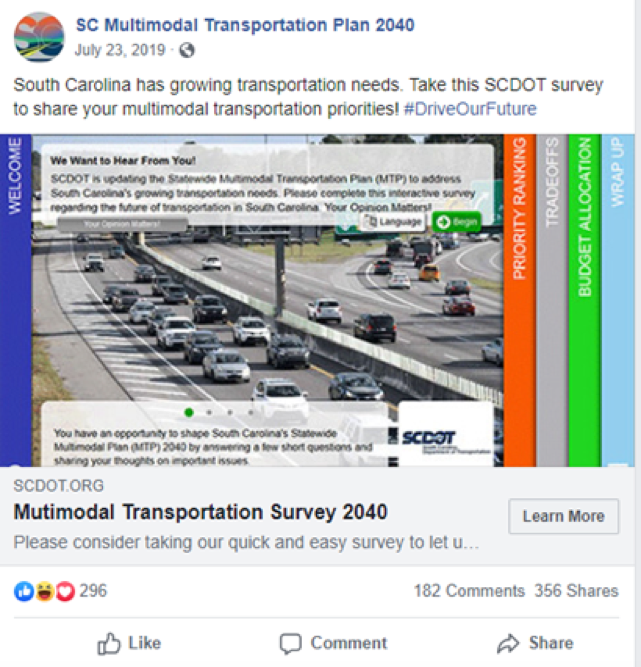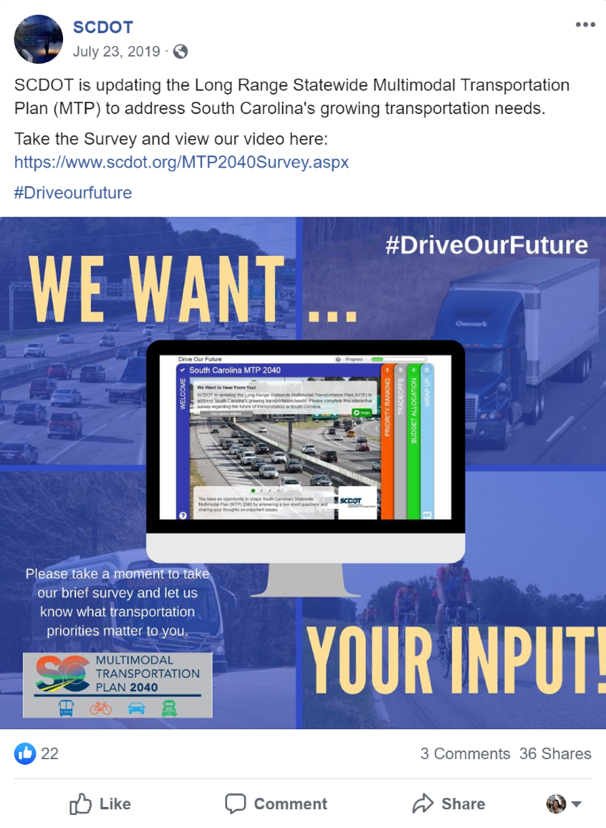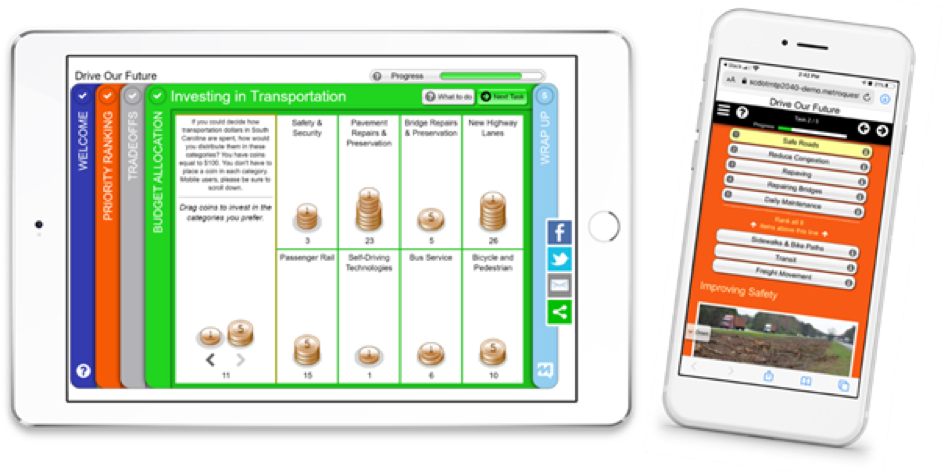SCDOT Said Goodbye to Public Meetings, Engaging 13,000+ Online with Facebook and a MetroQuest Survey!
![SCDOT [SUCCESS] SCDOT Said Goodbye to Public Meetings, Engaging 13,000+ Online with Facebook and a MetroQuest Survey!](https://metroquest.com/wp-content/uploads/SCDOT.jpeg)
Before the COVID-19 pandemic, the most common public engagement challenge reported by agencies was that community involvement in planning projects received low participation numbers. This was particularly true for in-person meetings, where declining participation was the trend. Despite expensive engagement strategies, the average number of attendees at public meetings was down to just 9 residents in 2019!
With these record-low numbers, it’s no wonder agencies have extended their community engagement to include online tools; not only to comply with new pandemic-related mandates that prohibit in-person meetings, but as a matter of course. The online transition has enabled planners nationwide to reach a much larger and broader audience to achieve record public engagement results!
In a recent post, I offered 5 tips for using Facebook to effectively promote public engagement surveys – a strategy that we’ve seen repeatedly utilized by our clients with great success. Today, let’s explore how this strategy worked brilliantly for the South Carolina Department of Transportation (SCDOT) to overcome declining participation numbers at public meetings.
Is online engagement a good alternative to public meetings?
In January 2020, we had the pleasure of hosting a webinar featuring our friends at SCDOT. Nicole Riddle, Public Involvement Coordinator, and her colleague Stephen Allen, Program Manager and Asset Manager, shared some interesting insights that answer this question.
They told us that, historically, a public meeting cost them an average of $20,000 USD. Expenses included newspaper advertising, travel costs, facilities, signage, staff time, as well as consulting rates and fees. For their last Multimodal Transportation Plan in 2014, the SCDOT team beat the national average, welcoming 13 participants per public meeting. They held 7 meetings, spending around $140,000 for a total of 94 participants. That’s $1,489 per participant!
In 2019, when the team started the process of updating its Long Range Statewide Multimodal Transportation Plan (MTP) to address the state’s growing transportation needs, they decided to move away from public meetings altogether. The team wanted to reinvent their public outreach to engage more people in the most cost-effective way possible. Nicole boldly told us that “public meetings are a waste of time and money.” When seeking high participation and large volumes of quantifiable public input for a long-range plan, public meetings alone usually leave planters wanting alternative solutions.
This is likely why nearly 800 planners and public participation professionals registered for the SCDOT webinar in January – they were curious and eager to learn “How SCDOT Engaged 13,000+ Residents on a Tiny Budget.”
SCDOT collected informed public input from 13,000+ residents for less than the cost of one public meeting!
By using Facebook boosted posts to promote SCDOT’s MetroQuest survey, Nicole and her team was spectacularly successful in engaging residents. They increased participation numbers more than 14,000% compared to the previous iteration of public outreach. To state this in numbers, in 2014, they had 94 attendees total from 7 public meetings, compared to 13,290 respondents for their recent online survey! Before we dive into SCDOT’s phenomenal social media results, let’s review the online survey.
How Great Survey Design Helps Inform and Engage Thousands of Residents
To help build her MetroQuest survey, Nicole reviewed some of the many existing surveys on the same topic from other customers. She wanted to design a survey that would serve as both a data collection and an educational tool, particularly around tradeoffs and making transportation choices. You can try a demo version of the SCDOT survey here:
First, the MetroQuest survey asked participants to rank their top priorities for transportation over the next 20 years. The priority list included Sidewalks & Bike Paths, Freight Movement, Daily Maintenance, Transit, Repairing Bridges, Reduce Congestion, Repaving, and Safe Roads. People liked to be asked about their priorities – and asking this question up front always helps drive great survey participation.
Then, Georgians were asked to decide how investments should be made by exploring tradeoffs in four categories namely Infrastructure, Mobility, Safe and Secure Travel, as well as Passenger Transit. For example, should SCDOT increase transit service on popular routes or add new routes? While all the options contribute to the creation and maintenance of a successful transportation system in the long-term, tradeoffs needed to be made in each category.
In the final exercise, before asking demographic questions, participants played a budget allocation game. They spent coins equaling $100 on the following categories: Safety & Security, Pavement Repairs & Preservation, Bridge Repairs & Preservation, New Highway Lanes, Passenger Rail, Self-Driving Technologies, Bus Service, and Bicycle and Pedestrians. This helped Georgians gain appreciation for working with a limited budget to prioritize transportation investments.
By taking the MetroQuest survey, Georgians learned about SCDOT’s Long Range Statewide MTP and the nuances and tradeoffs of planning, while also providing valuable input about their priorities. Nicole and Stephen collected over 287,000 data points to better inform their plan with statewide, informed public input.
The engagement experience was so colorful, interesting and interactive that this MetroQuest survey had an impressive 70% conversion rate. That is, of the 19,000 people who visited the survey, 13,290 answered the questions! That’s remarkable, especially when compared to the standard completion rate of 10 to 15% for online text-based surveys. The average completion rate for a MetroQuest survey is typically closer to 50%.
A great online public engagement survey can certainly yield outstanding results, but how did SCDOT get nearly twenty thousand Georgians to visit the survey?
SCDOT had great success using Facebook boosted posts to promote its online survey!
The team at SCDOT used a range of different avenues to advertise their MTP 2040 survey, but using Facebook boosted posts was their most successful. The following boosted post was short, to the point, with a clear call to action and a link to the survey. It even included their own hashtag.

This Facebook boosted post received almost 300 reactions, 350 shares and over 180 comments. With boosted posts, SCDOT reached almost 60,000 people and got over 6,500 clicks – all that with a budget of only $3,000.
In comparison, one of SCDOT’s non-boosted posts received 22 reactions, 3 comments and 26 shares, despite the agency having almost 60,000 followers on Facebook.

What’s the difference? Non- boosted posts go to the current audience, i.e., people who like and/or follow your Facebook page, while boosted posts reach beyond. Non-boosted posts on hot topics can sometimes do very well. They can also be a good way to test different post messaging and images so that you can then boost your most effective posts. SCDOT used its boosted posts to achieve these incredible results (for just $3,000, between July 30 and August 31, 2019:
- 59,329 people reached
- 6,547 total survey link clicks
- 46 cents per click
SCDOT also used the share buttons within the MetroQuest survey to encourage Georgians to share the survey with friends and colleagues, further broadening reach.
A smart social media strategy plus a great MetroQuest design helped our friends Nicole and Stephen achieve outstanding public participation. They successfully:
- Increased public participation from 94 to 13,290 Georgians
- Increased comments from 94 to 2,000 to provide context
- Saved over $100,000 by eliminating public meetings, with a much higher return value
- Collected 287,000 data points to support a 10-year investment plan
These efforts will drive further outreach efforts, help support future decisions, build transparency and foster public trust. These public engagement outcomes are truly impressive – congratulations to Nicole, Stephen and the entire SCDOT team for your amazing success.
For more tips on how to engage thousands on a small budget, you can watch the on-demand webinar with SCDOT here.
How SCDOT Engaged 13,000+ Residents on a Tiny Budget
The South Carolina Department of Transportation was looking to reinvent its public outreach to engage more people in the most cost-effective way possible. They hit it out of the park!

